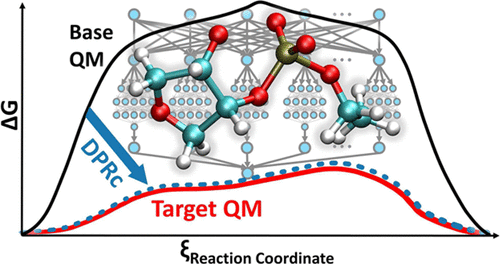当前位置:
X-MOL 学术
›
J. Chem. Theory Comput.
›
论文详情
Our official English website, www.x-mol.net, welcomes your
feedback! (Note: you will need to create a separate account there.)
Development of Range-Corrected Deep Learning Potentials for Fast, Accurate Quantum Mechanical/Molecular Mechanical Simulations of Chemical Reactions in Solution
Journal of Chemical Theory and Computation ( IF 5.7 ) Pub Date : 2021-10-13 , DOI: 10.1021/acs.jctc.1c00201 Jinzhe Zeng 1 , Timothy J Giese 1 , Şölen Ekesan 1 , Darrin M York 1
Journal of Chemical Theory and Computation ( IF 5.7 ) Pub Date : 2021-10-13 , DOI: 10.1021/acs.jctc.1c00201 Jinzhe Zeng 1 , Timothy J Giese 1 , Şölen Ekesan 1 , Darrin M York 1
Affiliation

|
We develop a new deep potential─range correction (DPRc) machine learning potential for combined quantum mechanical/molecular mechanical (QM/MM) simulations of chemical reactions in the condensed phase. The new range correction enables short-ranged QM/MM interactions to be tuned for higher accuracy, and the correction smoothly vanishes within a specified cutoff. We further develop an active learning procedure for robust neural network training. We test the DPRc model and training procedure against a series of six nonenzymatic phosphoryl transfer reactions in solution that are important in mechanistic studies of RNA-cleaving enzymes. Specifically, we apply DPRc corrections to a base QM model and test its ability to reproduce free-energy profiles generated from a target QM model. We perform these comparisons using the MNDO/d and DFTB2 semiempirical models because they differ in the way they treat orbital orthogonalization and electrostatics and produce free-energy profiles which differ significantly from each other, thereby providing us a rigorous stress test for the DPRc model and training procedure. The comparisons show that accurate reproduction of the free-energy profiles requires correction of the QM/MM interactions out to 6 Å. We further find that the model’s initial training benefits from generating data from temperature replica exchange simulations and including high-temperature configurations into the fitting procedure, so the resulting models are trained to properly avoid high-energy regions. A single DPRc model was trained to reproduce four different reactions and yielded good agreement with the free-energy profiles made from the target QM/MM simulations. The DPRc model was further demonstrated to be transferable to 2D free-energy surfaces and 1D free-energy profiles that were not explicitly considered in the training. Examination of the computational performance of the DPRc model showed that it was fairly slow when run on CPUs but was sped up almost 100-fold when using NVIDIA V100 GPUs, resulting in almost negligible overhead. The new DPRc model and training procedure provide a potentially powerful new tool for the creation of next-generation QM/MM potentials for a wide spectrum of free-energy applications ranging from drug discovery to enzyme design.
中文翻译:

开发范围校正的深度学习潜力,用于溶液中化学反应的快速、准确的量子力学/分子力学模拟
我们开发了一种新的深度潜能—范围校正 (DPRc) 机器学习潜能,用于结合量子力学/分子力学 (QM/MM) 模拟凝聚相中的化学反应。新的范围校正使短程 QM/MM 相互作用能够被调整以获得更高的精度,并且校正在指定的截止点内平滑消失。我们进一步开发了一种用于鲁棒神经网络训练的主动学习程序。我们针对溶液中的一系列六种非酶磷酸转移反应测试了 DPRc 模型和训练程序,这些反应在 RNA 切割酶的机理研究中很重要。具体来说,我们将 DPRc 校正应用于基础 QM 模型,并测试其重现从目标 QM 模型生成的自由能曲线的能力。我们使用 MNDO/d 和 DFTB2 半经验模型进行这些比较,因为它们在处理轨道正交化和静电学的方式上有所不同,并且产生的自由能曲线彼此之间存在显着差异,从而为我们提供了对 DPRc 模型和培训程序。比较表明,自由能分布的准确再现需要将 QM/MM 相互作用校正到 6 Å。我们进一步发现模型的初始训练受益于从温度副本交换模拟生成数据并将高温配置纳入拟合过程,因此训练所得模型以正确避开高能区域。训练了一个 DPRc 模型来重现四种不同的反应,并与目标 QM/MM 模拟产生的自由能曲线非常一致。DPRc 模型进一步证明可转移到训练中未明确考虑的 2D 自由能表面和 1D 自由能剖面。对 DPRc 模型的计算性能的检查表明,它在 CPU 上运行时相当慢,但在使用 NVIDIA V100 GPU 时加速了近 100 倍,导致几乎可以忽略不计的开销。新的 DPRc 模型和训练程序为从药物发现到酶设计等广泛的自由能应用创造下一代 QM/MM 潜力提供了一个潜在的强大新工具。DPRc 模型进一步证明可转移到训练中未明确考虑的 2D 自由能表面和 1D 自由能剖面。对 DPRc 模型的计算性能的检查表明,它在 CPU 上运行时相当慢,但在使用 NVIDIA V100 GPU 时加速了近 100 倍,导致几乎可以忽略不计的开销。新的 DPRc 模型和训练程序为从药物发现到酶设计等广泛的自由能应用创造下一代 QM/MM 潜力提供了一个潜在的强大新工具。DPRc 模型进一步证明可转移到训练中未明确考虑的 2D 自由能表面和 1D 自由能剖面。对 DPRc 模型的计算性能的检查表明,它在 CPU 上运行时相当慢,但在使用 NVIDIA V100 GPU 时加速了近 100 倍,导致几乎可以忽略不计的开销。新的 DPRc 模型和训练程序为从药物发现到酶设计等广泛的自由能应用创造下一代 QM/MM 潜力提供了一个潜在的强大新工具。对 DPRc 模型的计算性能的检查表明,它在 CPU 上运行时相当慢,但在使用 NVIDIA V100 GPU 时加速了近 100 倍,导致几乎可以忽略不计的开销。新的 DPRc 模型和训练程序为从药物发现到酶设计等广泛的自由能应用创造下一代 QM/MM 潜力提供了一个潜在的强大新工具。对 DPRc 模型的计算性能的检查表明,它在 CPU 上运行时相当慢,但在使用 NVIDIA V100 GPU 时加速了近 100 倍,导致几乎可以忽略不计的开销。新的 DPRc 模型和训练程序为从药物发现到酶设计等广泛的自由能应用创造下一代 QM/MM 潜力提供了一个潜在的强大新工具。
更新日期:2021-11-09
中文翻译:

开发范围校正的深度学习潜力,用于溶液中化学反应的快速、准确的量子力学/分子力学模拟
我们开发了一种新的深度潜能—范围校正 (DPRc) 机器学习潜能,用于结合量子力学/分子力学 (QM/MM) 模拟凝聚相中的化学反应。新的范围校正使短程 QM/MM 相互作用能够被调整以获得更高的精度,并且校正在指定的截止点内平滑消失。我们进一步开发了一种用于鲁棒神经网络训练的主动学习程序。我们针对溶液中的一系列六种非酶磷酸转移反应测试了 DPRc 模型和训练程序,这些反应在 RNA 切割酶的机理研究中很重要。具体来说,我们将 DPRc 校正应用于基础 QM 模型,并测试其重现从目标 QM 模型生成的自由能曲线的能力。我们使用 MNDO/d 和 DFTB2 半经验模型进行这些比较,因为它们在处理轨道正交化和静电学的方式上有所不同,并且产生的自由能曲线彼此之间存在显着差异,从而为我们提供了对 DPRc 模型和培训程序。比较表明,自由能分布的准确再现需要将 QM/MM 相互作用校正到 6 Å。我们进一步发现模型的初始训练受益于从温度副本交换模拟生成数据并将高温配置纳入拟合过程,因此训练所得模型以正确避开高能区域。训练了一个 DPRc 模型来重现四种不同的反应,并与目标 QM/MM 模拟产生的自由能曲线非常一致。DPRc 模型进一步证明可转移到训练中未明确考虑的 2D 自由能表面和 1D 自由能剖面。对 DPRc 模型的计算性能的检查表明,它在 CPU 上运行时相当慢,但在使用 NVIDIA V100 GPU 时加速了近 100 倍,导致几乎可以忽略不计的开销。新的 DPRc 模型和训练程序为从药物发现到酶设计等广泛的自由能应用创造下一代 QM/MM 潜力提供了一个潜在的强大新工具。DPRc 模型进一步证明可转移到训练中未明确考虑的 2D 自由能表面和 1D 自由能剖面。对 DPRc 模型的计算性能的检查表明,它在 CPU 上运行时相当慢,但在使用 NVIDIA V100 GPU 时加速了近 100 倍,导致几乎可以忽略不计的开销。新的 DPRc 模型和训练程序为从药物发现到酶设计等广泛的自由能应用创造下一代 QM/MM 潜力提供了一个潜在的强大新工具。DPRc 模型进一步证明可转移到训练中未明确考虑的 2D 自由能表面和 1D 自由能剖面。对 DPRc 模型的计算性能的检查表明,它在 CPU 上运行时相当慢,但在使用 NVIDIA V100 GPU 时加速了近 100 倍,导致几乎可以忽略不计的开销。新的 DPRc 模型和训练程序为从药物发现到酶设计等广泛的自由能应用创造下一代 QM/MM 潜力提供了一个潜在的强大新工具。对 DPRc 模型的计算性能的检查表明,它在 CPU 上运行时相当慢,但在使用 NVIDIA V100 GPU 时加速了近 100 倍,导致几乎可以忽略不计的开销。新的 DPRc 模型和训练程序为从药物发现到酶设计等广泛的自由能应用创造下一代 QM/MM 潜力提供了一个潜在的强大新工具。对 DPRc 模型的计算性能的检查表明,它在 CPU 上运行时相当慢,但在使用 NVIDIA V100 GPU 时加速了近 100 倍,导致几乎可以忽略不计的开销。新的 DPRc 模型和训练程序为从药物发现到酶设计等广泛的自由能应用创造下一代 QM/MM 潜力提供了一个潜在的强大新工具。











































 京公网安备 11010802027423号
京公网安备 11010802027423号